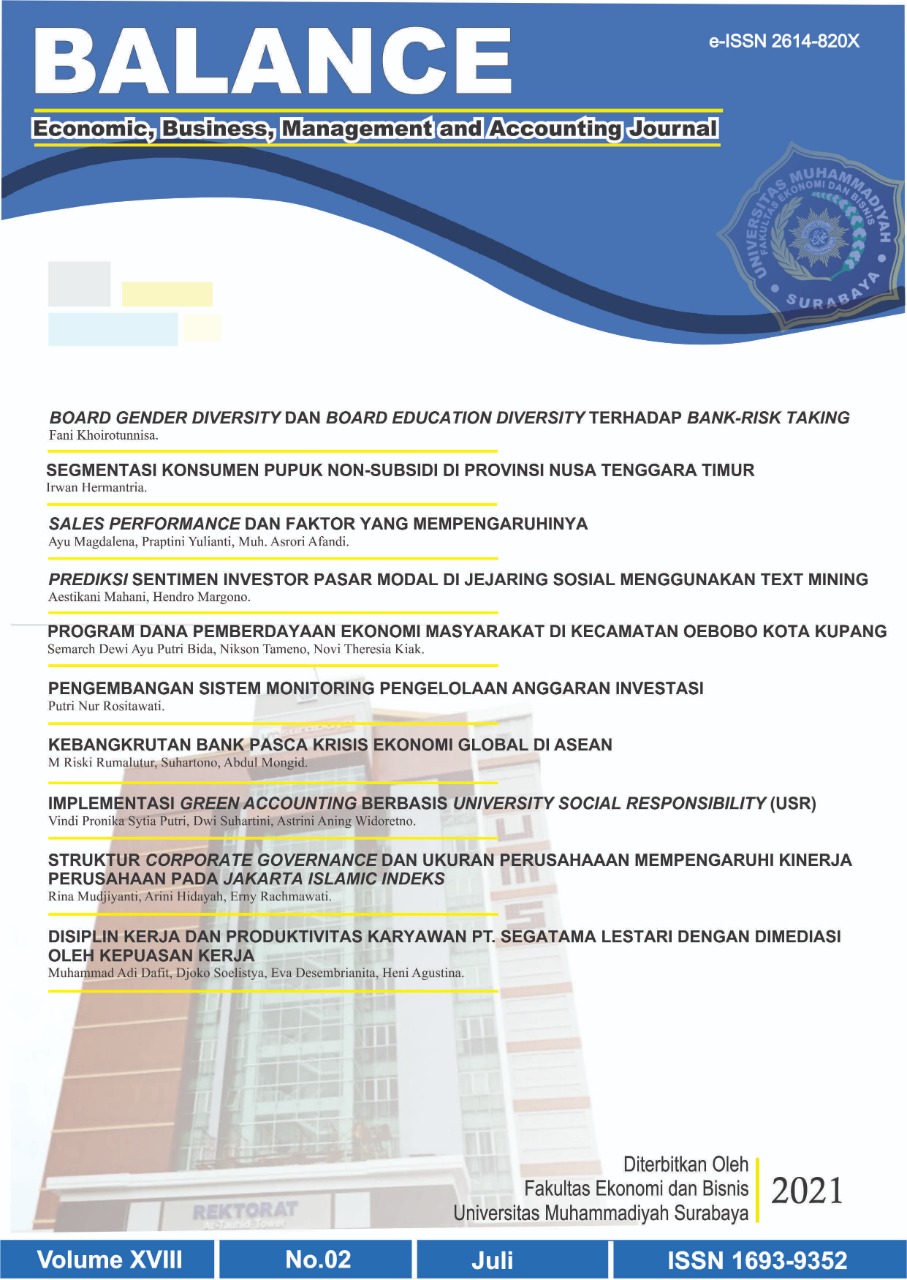Prediksi Sentimen Investor Pasar Modal Di Jejaring Sosial Menggunakan Text Mining
DOI:
https://doi.org/10.30651/blc.v18i2.7226Abstrak
The decline in optimism for capital market investors is one of the financial impacts on the business world that arose from the SARS-COVID19 pandemic. This event was reflected in a decrease in trading volume followed by a sharp drop in the JCI on the Indonesia Stock Exchange starting March 2020. Thus, a slowdown in the economic recovery resulting from the pandemic is reflected in investor sentiment in the capital market. On the one hand, the rapid development of the internet in Indonesia has triggered the investor's activities in the information searching prior buy and sell securities, mostly use online platforms, which contribute to influencing investor preferences and sentiment. This study conducted a qualitative examination of the features/terms of stock investment in the capital market and collected them in a compact dictionary (lexicon). Therefore, lexicon-based investor opinion extraction was extracted from Twitter, followed by the text sentiment analysis, and forming a classification model based on Naive Bayes and Decision Tree. This research output shows that the polarity of capital market investor sentiment is optimistic with the sentiment features that often appear, namely "cuan", "bearish," "serok", "copet", "untung", "cut loss", and "nyangkut." Meanwhile, the Decision Tree classification model provides better performance.
Keywords                      :  investor, lexicon, social network, stock exchange, text mining
Correspondence to       : aestikani.mahani-2019@feb.unair.ac.id
Â
Penurunan optimisme investor pasar modal adalah salah satu dampak keuangan pada dunia usaha yang timbul akibat pandemi SARS-COVID19. Hal ini tercermin dari turunnya volume perdagangan yang diikuti penurunan tajam IHSG di Bursa Efek Indonesia mulai Maret 2020. Sehingga kekhawatiran atas perlambatan pemulihan ekonomi sebagai dampak pandemi, tercermin dari sentimen investor di pasar modal. Di satu sisi, perkembangan internet di Indonesia yang pesat, memicu kecenderungan aktivitas investor dalam pencarian informasi sebelum membeli dan menjual surat berharga  secara online, turut berkontribusi dalam mempengaruhi preferensi dan sentimen investor. Penelitian ini menggali ekspektasi investor yang tercermin pada sentimen investasi, dimana pasar modal sebagai salah satu barometer penting perekonomian suatu negara. Kajian ini mengeksplorasi fitur/terms investasi saham yang kerap muncul di pasar modal dan mengumpulkannya dalam kamus leksikon. Kemudian, dilakukan ekstraksi opini investor berbasis leksikon yang digali dari jejaring sosial Twitter, dilanjutkan dengan tahap text mining yaitu menganalisis sentimen, dan membentuk model klasifikasi berbasis Naive Bayes dan Decision Tree. Keluaran penelitian ini  menunjukkan bahwa polaritas sentimen investor pasar modal adalah positif dengan fitur sentimen yang sering muncul yaitu “cuanâ€, “bearishâ€, “serokâ€, “copetâ€, “untungâ€, dan “cut lossâ€. Sedangkan model klasifikasi Decision Tree memberikan performansi akurasi yang kebih baik.
Kata Kunci                 : Analisis sentimen; Investor; Leksikon; Text mining; Twitter
Referensi
Abdillah, J., & Handoko, H. . (2012). Motivation and Consequence of Individual's Involvement in Social Network Sites : A Study of Social Computing of Inter Collectivist-Individualist Cultural Value. Jornal of Economy and Business, 27, 31.
Adamopoulos, D. B., V. (2013). Exploring the Social Networks of Online Investors. Paper presented at the 24 th Australasian Conference on Information Systems, Melbourne.
Akerlof, G. (1970). The Market for "Lemons": Quality Uncertainty and the Market Mechanism. The Quarterly Journal of Economics, No. 3, 84, 14.
Anandarajan, M., Hill, & Nolan, T. (2019). Practical Text Analytics: Maximizing the Value of Text Data. In Vol. 2. R. Sharda (Ed.). doi:https://doi.org/10.1007/978-3-319-95663-3
Bahasa, B. P. d. P. (2020, Jan 2021). Kamus Besar Bahasa Indonesia -KBBI- Kamus versi daring. Retrieved from https://kbbi.web.id/sentimen
Bar-Haim, D., E., Feldman, R., Fresko, & Goldstein, G. (2011). Identifying and Following Expert Investors in Stock Microblogs. Paper presented at the Conference on Empirical Methods in Natural Language Processing, Edinburgh.
Brown, E. (2012, January 2012). Will twitter make you a better investor? A look at sentiment, user reputation and Their Effect on Stock Market. Paper presented at the Proceedings of the Southern Association for Information Systems Conference, Atlanta, GA, USA.
Chiarello, F., Bonaccorsi, A., & Fantoni, G. . (2020). Technical Sentiment Analysis: Measuring Advantages and Drawbacks of New Products Using Social Media. Computers in Industry(103299), 12. doi:https://doi.org/10.1016/j.compind.2020.103299
Christopoulos, G., Tobler, P., Bossaerts, Dolan, & Schultz, W. (2009). Neural Correlates of Value, Risk, and Risk Aversion Contributing to Decision Making under Risk. The Journal of Neuroscience. doi:10.1523/JNEUROSCI.2614-09.2009
Ciccone, S. J. (2011). Investor Optimism, False Hopes and the January Effect. Journal of Behavioural Finance, pp. 158-168,, 12, 158.
Creswell, J. C., P.V. (2018). Designing and Conducting Mixed Method Research. In.
Dong, Y., Wang, J., Chen, T. (2019). Price Linkage Rumors in the Stock Market and Investor Risk Contagion on Bilayer-Coupled Networks. Complexity, 21. doi:https://doi.org/10.1155/2019/4727868
Duan, J. Z., Jianping. (2013). Mining Opinion and Sentiment for Stock Return Prediction based on WebForum Messages. 10th International Conference on Fuzzy Systems and Knowledge Discovery (FSKD), 984.
Dube, R. (2021). Characteristics of Social Networks. Retrieved from https://socialnetworking.lovetoknow.com/Characteristics_of_Social_Networks
Felton, J., Gibson, & Sanbonmatsu. (2003). Preference for Risk in Investing as a Function of Trait Optmism and Gender. Journal of Behavioural Finance.
Han, J. K., Micheline ; Pei Jian. (2012). Data Mining, Concepts and Techniques (3 ed.). USA: Elsevier.
Hoffman, M., G. (1999). Problem with Peirce's Concept of Abduction Journal of Foundation Science, 4, 33. doi:https://doi.org/10.1023/A:1009675824079
Hridoy, S. A., Ekram, M. T., Islam, Mohammad, Faysal, A., Rahman, Rashedur. (2015). Localized twitter opinion mining using sentiment analysis, Decision Analytics. ECONSTOR, 2(1), 1-19. doi:http://dx.doi.org/10.1186/s40165-015-0016-4
Ignatouw, G. M. (2018). An Introduction to Text Mining: Research Design, Data Collection, and Analysis. In H. Salmon (Ed.). Retrieved from https://study.sagepub.com/introtextmining
Iqbal, N. (2015). Impact of Optimism Bias on Investment Decision: Evidence from Islamabad Stock Exchange, Pakistan. Research Journal of Finance and Accounting, 9(19), 6. doi:https://core.ac.uk/download/pdf/234631087.pdf
Jefferson, J. S., N. (2014). Shopping Saham Modal Sejuta (2 ed.). Jakarta: Elex Media Komputindo.
JKSE. (2020). Yahoo Finance. Retrieved from https://finance.yahoo.com/quote/%5EJKSE/history?period1=1580515200&period2=1590710400&interval=1d&filter=history&frequency=1d
Kuhnen, C. K., B. (2005). The Neural Basis of Financial Risk Taking. Neuron, 47, 763-770.
Kumar, S. R., V. (2016). A survey of the applications of text mining in financial domain. Knowledge based-System, 114, 128-147.
Leon, F. M. P., R. R. (2019). The Impact of Overconfidence and Optimism on Investment Decision on Individual Investor in Indonesia. Jurnal Akuntansi, 9(2), 93-102.
Luo, B., Zeng, J., & Duan, J. (2015). Emotion Space Model for Classifying Opinions in Stock Message. Expert Systems With Applications, 12. doi:10.1016/j.eswa.2015.08.023
Luo, Y., & Yang, X. (2014). Rumor Clarification and Stock Returns: Do Bull Market Behaves Differently from Bear Markets? Emerging Markets Finance & Trade, 50, 197-209. doi:10.2753/REE1540-496X500111
Maisam A., R., Tabassamand, & Abbas, T. (2017). Effect of Optimism, Overconfidence, and Status Quo Bias on Stock Market Perceived Performance: Evidence from Islamabad Stock Exchange. International Journal of Economics & Finance Research & Applications, 1(2).
Makhabel, M., Pradeepta, Danneman, & Heimann. (2017). R: Mining Spatial, Text, Web, and Social Media Data (T. Shriyan Ed.). Birmingham, UK: Packt Publishing Ltd.
Margono H., Y., & Raikundalia, G. (2015). Clustering Indonesian Cyberbullying Words in Social Network. International Journal of Computer Science and Electronics Engineering (IJCSEE), 3(4), 274.
Morse, J., Barrett, Mayan, Olson, K., & Spiers, J., . (2002). Verification Strategies for Establishing Reliability and Validity in Qualitative Research. International Journal of Qualitative Methods, 1(2), 11.
Nemati H.R, B. (2005). Organizational Data Mining. In. Retrieved from https://doi.org/10.1007/0-387-25465-X_50
Nikfarjam, A. E., & Muthaiyah. (2010). Text mining approaches for stock market prediction. Paper presented at the 2010 The 2nd International Conference on Computer and Automation Engineering (ICCAE).
Nuzula, R. M. F., N. . (2018). Does Investor Sentiment Affect Large-Cap and Small-Cap Stock. Jurnal Administrasi Bisnis (JAB), 59, 51-61.
Oppusunggu, L. S., I. P. . (2020). Coronavirus: How to Behave in Investment. Journal of Advanced Research in Dynamical & Control Systems, 12(06), 246-250.
Prayogi, I. S., Y. (2018). Jargon Pedagang Saham di Telegram. TOTOBUANG, 6(2).
Provost, F. F. T. (2013). Data Science for Business (M. L. a. M. Blanchette Ed. 1st ed.). Chicago: O'reilly.
Raorane, K., & Jitkar. (2012). Association Rule – Extracting Knowledge Using Market Basket Analysis. Research Journal of Recent Sciences, 1, 9. doi:http://www.isca.in
Raut, R. K. K., R. (2018). Investment Decision-Making Process between Different Groups of Investors : A Study of Indian Stock Market. Asia-Pacific Journal of Management Research and Innovation, 14(1-2), 11. doi:10.1177/2319510X18813770
Sadeq, A. J. (2019). Factors influencing Individual Investor Behaviour: Evidence from the. Asian Social Science, 15(3).
Scherer, K. R. (2005). What are emotions? And how can they be measured? Social Science Information, 44 (4), 35. doi:10.1177/0539018405058216
Shefrin, H. (2002). Beyond Greed and Fear : Understanding Behavioural Finance and Psychology of Investing: Oxford University Press.
Shi, Y., Tang, Y., Cui, & Long, W. (2019). A Text Mining Based Study of Investor Sentiment and Its Influence on Stock. Economic Computation and Economic Cybernetics Studies and Research, 52(1), 183.
Shiller, R. J. (2003). From Efficient Markets Theory to Behavioral Finance. The Journal of Economic Perspectives, 17(1), 83-104.
Slovic & Kerjan, E. (2010). The Irrational Economist: Making Decisions in a Dangerous World. In (pp. 336). New York Public Affairs.
Song, C. S., C. (2007). SOPS: Stock Prediction using Web Sentiment. Paper presented at the Seventh IEEE International Conference on Data Mining - Workshops, Maryland, USA.
Spence, M. (1974). Job Market Signaling. Quarterly Journal of Economics, 20.
Statman, M. (2019). Behavioural Finance : The Second Generation. In (pp. 248). doi: http://dx.doi.org/10.2139/ssrn.3668963
Suwardjono. (2010). Teori Akuntansi: Perekayasaan Pelaporan Keuangan. Yogyakarta: BPFE UGM.
Tauni, M. Z., HongXing, & Iqbal, A. (2016). Personality Matter?, Qualitative Research in Financial Markets. Qualitative Research in Financial Markets, 8, 35. doi:http://dx.doi.org/10.1108/QRFM-08-2015-0031
Turban, E., Volonino, L., & Wood, G. (2018). Information Technology for Management: On Demand Strategies for Performance, Growth, and Sustainabillity (B. L. Golub Ed. 10th ed.). Danvers, MA: Wiley.
Wardana, R. (2020). Apa Itu IHSG? Ini Pengertian, Manfaat, dan Cara Hitungnya. Retrieved from https://lifepal.co.id/media/ihsg/
Widyartati, P., Setyawati, I., & Ariyani, I. (2021). Kurs dan Nilai Perdagangan Saham di BEI Sebelum dan Pada Masa Pandemi COVID-19. Balance: Economic, Business, Management, and Accounting Journal, XVII(1), 10. doi:http://dx.doi.org/10.30651/blc.v18i1.5446
Yang, S., Mo, S. Y. Kevin, & Liu, A. (2015). Twitter financial community sentiment and its Predictive Relationship. Quantitative Finance Journal, 15(10), 1637-1656.















